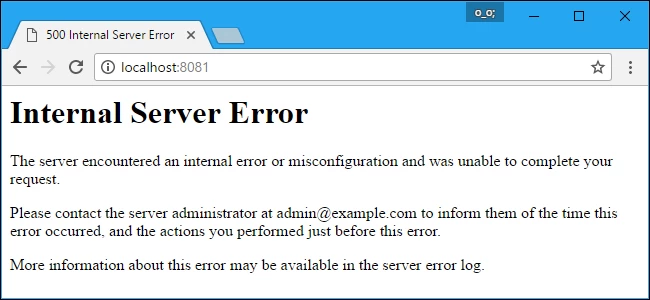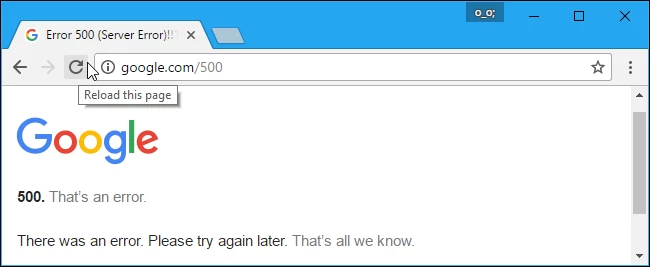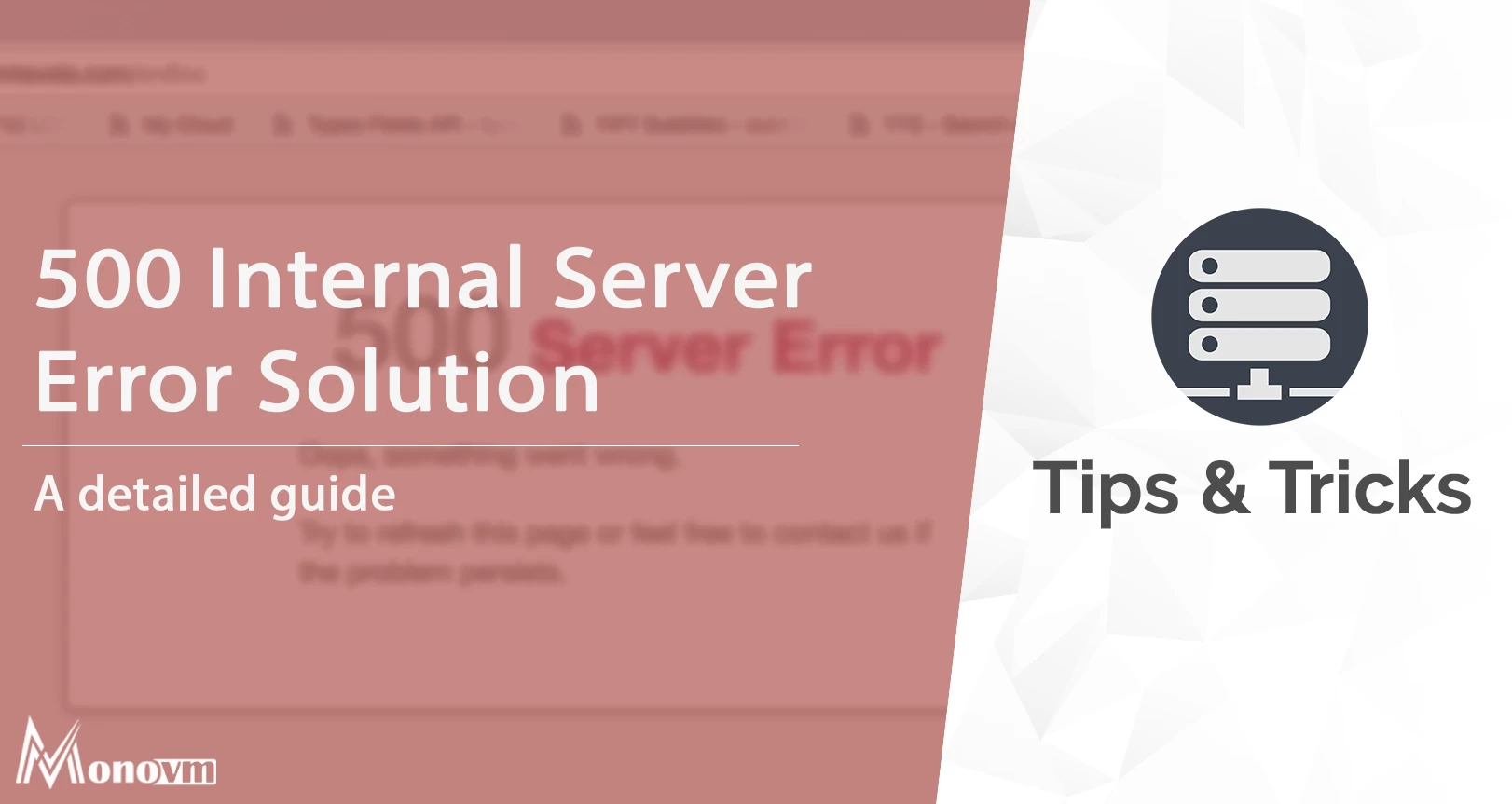List of content you will read in this article:
You might know the errors that tend to occur while sending a request to the web server. Various HTTP status codes specify the details about whether your request to the server was successful or not. If the request fails, what could be the reason for the internal server error?
However, a prevalent error can pop up anytime and without any obvious cause. This happens with HTTP 500 internal server errors, as the error message is unclear and doesn’t state much of what went wrong with the request. The message only specifies that there might be some issue while connecting to the server and that the request cannot be processed.
Every error has some fixes, so this 500 internal error can be fixed in various ways. There are many forms of 500 internal errors. All specify the same thing differently, which mentions the issue with connecting to the server. You often have to wait or contact the website directly to respond to the error. There can be an issue at your end, and we must find out and try to fix them as soon as possible without hindering our work.
This article will give you information about what is an internal server error, the causes of the 500 internal server error, and how you can fix it.
What is an Internal Server Error?
An internal server error means that your request to the web server was successful or not. This indicates that your web server is not configured correctly or your application/software fails to fulfill the request due to a configuration error or restriction. It is possible to fix this type of server error with the help of web server software.
There is nothing to worry about for some other kind of code that your browser or the client receives 200 status codes, as it specifies that everything went well while requesting. The situation is different if you get 400 and 500 status codes on your browser, where 400 specifies the client errors and 500 specifies the server-related issues, which may vary without any specific error message.
What is a 500 Internal Server Error?
The 500 server error is difficult to understand without any message displayed on the browser. The user will know that something fishy has occurred at the server end without any particular reason. If you have Microsoft Internet Information Services installed on your server, you can get a specific error message stating the cause of the expected error.
The following is a list of the 500 internal server errors with a particular message.
HTTP error 500 List
|
Code |
Explanation |
|
500.0 |
It specifies that an issue regarding the Module or ISAPI has occurred. |
|
500.11 |
It specifies that an application has been shut down on the webserver. |
|
500.12 |
It specifies that an application is getting restarted on the webserver. |
|
500.13 |
This error specifies that a web server is too busy to respond. |
|
500.15 |
It specifies that direct requests for Global.asax are not allowed at the moment. |
|
500.19 |
It specifies that you have invalid configuration data. |
|
500.21 |
It specifies that the modules are not getting recognized. |
|
500.22 |
It specifies that the ASP.NET httpModules configuration cannot be applied in the Managed Pipeline mode. |
|
500.23 |
It specifies that the ASP.NET httpHandlers configuration cannot be applied in the Managed Pipeline mode. |
|
500.24 |
It specifies that the ASP.NET impersonation configuration cannot be applied in the Managed Pipeline mode. |
|
500.50 |
This rewrite error occurred while handling the RQ_BEGIN_REQUEST notification. It specifies that an error occurred due to the configuration or inbound rule execution at the server end. |
|
500.51 |
This rewrite error occurred while handling the GL_PRE_BEGIN_REQUEST notification. It specifies that an error has occurred due to the global configuration or global rule execution. |
|
500.52 |
This rewrite error occurred while handing the RQ_SEND_RESPONSE notification. It specifies that an outbound rule execution error has occurred at the server end. |
|
500.53 |
This rewrite error occurred while handling the RQ_RELEASE_REQUEST_STATE notification. It specifies that an outbound rule execution error has occurred. You have to configure the rule before updating the output user cache. |
|
500.100 |
It specifies that an Internal ASP error has occurred. |
How Does the 500 Internal Server Error Look?
There are various ways to get 500 internal server errors, which may vary from website to website you are accessing. But all the different forms of the error message indicating that something is wrong at the server end.
Below are the various HTTP 500 error forms that occurred on your browser:
- 500 Internal Server Error
- HTTP 500 - Internal Server Error
- Temporary Error (500)
- Internal Server Error
- HTTP 500 Internal Error
- 500 Error
- HTTP Error 500
- 500. That's an error



Various Causes of the 500 Internal Server Error
The 500 internal server error can occur unplanned and cause trouble loading your website. There can be many reasons for this error to be encountered on the server side. But if it is your website, then take countermeasures to make sure the website is accessible all the time.
Here are some common reasons for this error to occur.
- Permission Error: One of the most common reasons is due to the improper permission for some files required to access the server. These errors could be networking problems, user mistakes, or bugs. Alternatively, this error could be the permission to PHP and CGI script causing the issue. Changing the user’s permission to 0755 could prevent this problem from occurring repeatedly.
- PHP Timeout: It is due to the timeout of the resources required to run required files or scripts. By handling scripts in a better way, you can avoid the situation.
- Coding Error in .htaccess File: To avoid the 500 internal server error, ensure the .htaccess file is structured correctly. This file entails instructions that direct your website to enable and disable specific functions. In addition, those instructions might also help you protect passwords in a directory.
- PHP Memory Limit: PHP is a server-side scripting language that manages content, databases, session tracking, etc. Each PHP process consumes memory, and the hosting account limits the memory for each process. If your website needs more memory than the specified limit, you get the 500 internal server error.
- Error Logs: They check for Apache and PHP error logs, and you will get failure details.
- Faulty Third-Party Plugins and Themes: You may need to use third-party plugins and themes to add extra functionality to your website. Though these plugins may be useful, they can also impact your website’s security and performance if faulty.
Ways to Fix 500 Internal Server Errors
We have discussed some ways to overcome the issue, which may be due to the website’s server. It may be possible that the problem resides from our end, and we can try a few things to make that work.
1. Reloading the Web Page
Try reloading the webpage using the F5 or Ctrl+R option, or pressing the URL and then Enter. If the 500 error persists after reloading the website again, it might be a temporary issue that will resolve in a few minutes.
2. Clearing Browser’s Cache
There can be an issue with the cached version of the webpage you are trying to access. Therefore, try clearing the cache for the website to make it work.
3. Deleting Browser’s Cookies
You can avoid HTTP error 500 by deleting the cookies for the website. Once you delete the cookies, restart your browser to re-access the website.
4. Contacting the Website
If you are unsure how to eliminate this error, you can try contacting the website administrator to look into the error. They might help you troubleshoot it. If they are also not sure, then try open-source portals where you can possibly find a solution.
5. Server Timeout
This error may cause the server timeout or script to get timed out. You can avoid this issue by increasing the Apache server timeout from the http.config file and expand it to 600 to work properly. If the server is busy, then reboot it. If the connection fails again, you will face the 500 server error again.
6. Create a Site Backup
For this, make changes to the website’s root directory. It is recommended to back up your site before making the changes so that you can roll back in case of further failure.
Conclusion
Though 500 internal server errors are prevalent but frustrating to encounter them as you do not know what is causing it and how you will resolve it, we hope you learned how to fix 500 internal server errors to keep your website running. There could be many reasons for this 500 server error, but there is no single way to fix it completely.
Try implementing different solutions until you get it resolved. Once you are an expert, resolving the issue will take no time, and you need not worry about where to look if a particular error persists. If you think there are other solutions available to solve the internal server, list your ideas in the comment section.
People Are Also Reading:
